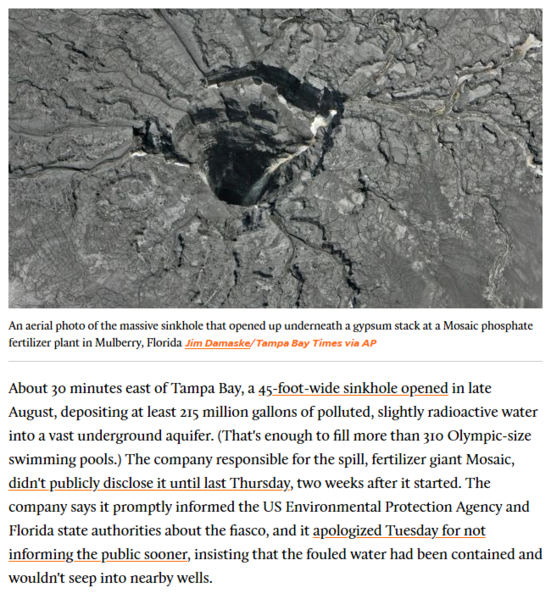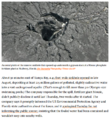File:Florida-Mosaic sinkhole 2016.png

Original file (650 × 707 pixels, file size: 441 KB, MIME type: image/png)
<addthis />
September 2016
http://www.motherjones.com/environment/2016/09/sinkhole-florida-radioactive-water-fertilizer
The ("Massive Sinkhole") occurred in a region known as Bone Valley, one of the the world's most productive and valuable stores of phosphate rock, the feedstock for phosphate fertilizer, used to replenish farm fields from the US corn belt to Brazil to Europe. (Here's more on the vexing geopolitics of the global phosphate market.) Florida's phosphate deposits form an obscure but crucial hub in the global food system—they provide about 75 percent of the nation's supply of phosphate fertilizer and about 25 percent of the world supply.
They're essentially ecological sacrifice zones. In Bone Valley mines, cranes equipped with huge buckets (big enough to hold a van) scrape gashes into the land, removing as much as 20 feet of earth to expose the phosphate, which is then mined and processed into fertilizer. For every ton of product, the process generates five tons of a waste product called phosphogypsum, which contains low levels of radiation as well as a range of toxic heavy metals. The region already houses nearly 1 billion tons of phosphogypsum, and 30 million additional tons emerge each year. In Florida, no one knows what to do with the stuff, so it has been accumulating in huge piles known as gyp stacks, of which there are 22 in central Florida.
And it was on one of the gyp stacks that the sinkhole formed, unleashing that vast pond of tainted water. And while Mosaic claims the leak won't contaminate the Floridian Aquifer, from which millions of people draw water, others are less sure.
Here's the Tampa Bay Times:
- [E]xtracting all of the contaminated water and sediment before it spreads will be extremely difficult, said Robert Brinkmann, a professor of geology and environmental sustainability at Hofstra University and author of Florida Sinkholes: Science and Policy. "That's the bad thing about this: The aquifer is like Swiss cheese and it's interconnected," Brinkmann said. "Contamination can be very rapid. They must be working very hard to figure out where this is going."
File history
Click on a date/time to view the file as it appeared at that time.
| Date/Time | Thumbnail | Dimensions | User | Comment | |
|---|---|---|---|---|---|
| current | 18:13, 21 September 2016 |  | 650 × 707 (441 KB) | Siterunner (talk | contribs) |
You cannot overwrite this file.
File usage
The following page uses this file: